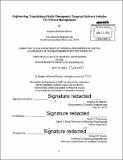Engineering translational multi-therapeutic targeted delivery vehicles for disease management
Author(s)
Morton, Stephen Winford
DownloadFull printable version (27.65Mb)
Alternative title
Engineering translational multi-therapeutic targeted delivery vehicles
Other Contributors
Massachusetts Institute of Technology. Department of Chemical Engineering.
Advisor
Paula T. Hammond.
Terms of use
Metadata
Show full item recordAbstract
The complexity of growth, survival, and death signaling pathways in cancer continues to motivate extensive investigations using systems biology approaches to better inform treatments. Many of these drugs and drug combinations, however, are highly toxic, due to lack of targeting and poor pharmacokinetics, and are not easily delivered together due to solubility issues - requiring high levels of patient compliance over the course of treatment whereby lower, less efficacious doses of therapies are administered during multiple intravenous infusions. To address this problem, development of delivery systems that are safe/less toxic, yet capable of housing and delivering higher, more efficacious doses with sophisticated levels of control over the delivery, timing, and/or sequence of release, in order to therapeutically re-wire these signaling pathways, is essential to translate these drug combinations to the clinic. Work detailed herein addresses this challenge by developing controlled approaches for engineering and manufacturing translational nanoscale delivery systems for more efficacious, targeted treatment of cancer - specifically using layer-by-layer nanoscale assembly and liposomal manufacture. Layer-by-Layer (LbL) assembly of polyelectrolytes on solid substrates, including colloidal systems, is a well characterized, tunable approach for generating functional thin films for a variety of applications, including drug and gene delivery, tissue engineering, and bone regeneration. On the basis of electrostatics, this assembly method allows for incorporation of a broad range of materials; and due to its water-based synthesis, it allows for incorporation of a broad range of therapeutics without significant alteration of biological function. Using this approach, work described in Chapters 2-4 detail the utility of this approach. In Chapter 2, we demonstrate the ability to coat materials atop drug-loaded PLGA nanoparticle substrates that control drug release and nanoparticle pharmacokinetics in a systemic environment. In Chapter 3, we incorporate ligand-functionalized materials atop a drug-loaded liposomal core to promote tissue-level specificity for targeted treatment of cancer. In Chapter 4, we further adapt this approach towards addressing the challenge of scalably and reproducibly manufacturing LbL-functionalized nanoparticle systems by collaborating with Joseph DeSimone at UNC-Chapel Hill. In this work, we combine scalable methods, PRINT® particle fabrication, and spray-LbL deposition, to generate uniform and functional nanotechnologies that are built-to-order with precise control over composition, size, shape, and surface functionality. In Chapters 5-7, targeted liposomal technologies were synthesized to deliver drug combinations with different solubilities. Liposomes, representing the first nanomedicine systems approved and employed in the clinic, are well-characterized, simple and versatile platforms for manufacture of functional and tunable drug-carrier systems. Further, functionalization of these systems for tissue-level specificity is readily achieved by ligand conjugation of a lipid that is subsequently inserted into the dual drug-loaded liposomal vesicular membrane. Utilizing the hydrophobic and hydrophilic compartments of liposomes, we achieved high loadings of both hydrophobic and hydrophilic therapies within a singular tissue-targeted (e.g. folate) liposomal system. The resultant nature of compartmentalization inside the vesicular structure promoted the desired sequence of drug release for synergistic cancer therapy, improving tumor cell killing in vitro and significant tumor shrinkage in in vivo murine triple-negative breast cancer and non-small cell lung cancer models. In Chapters 6 and 7, we applied this approach for targeted combination therapeutic delivery for additional drug therapies (e.g. cisplatin-quisinostat (HDAC inhibitor) in a folate-targeted liposome; (+)-JQ1-temozolomide in a transferrin-targeted liposome) and disease targets (non-small cell lung cancer; brain stem gliomas). Using both LbL and liposomal manufacture, work detailed herein represents a broad skill set for engineering and manufacturing translational targeted multi-therapeutic delivery systems with high levels of control.
Description
Thesis: Sc. D., Massachusetts Institute of Technology, Department of Chemical Engineering, June 2015. Cataloged from PDF version of thesis. "May 21, 2015." Includes bibliographical references.
Date issued
2015Department
Massachusetts Institute of Technology. Department of Chemical EngineeringPublisher
Massachusetts Institute of Technology
Keywords
Chemical Engineering.